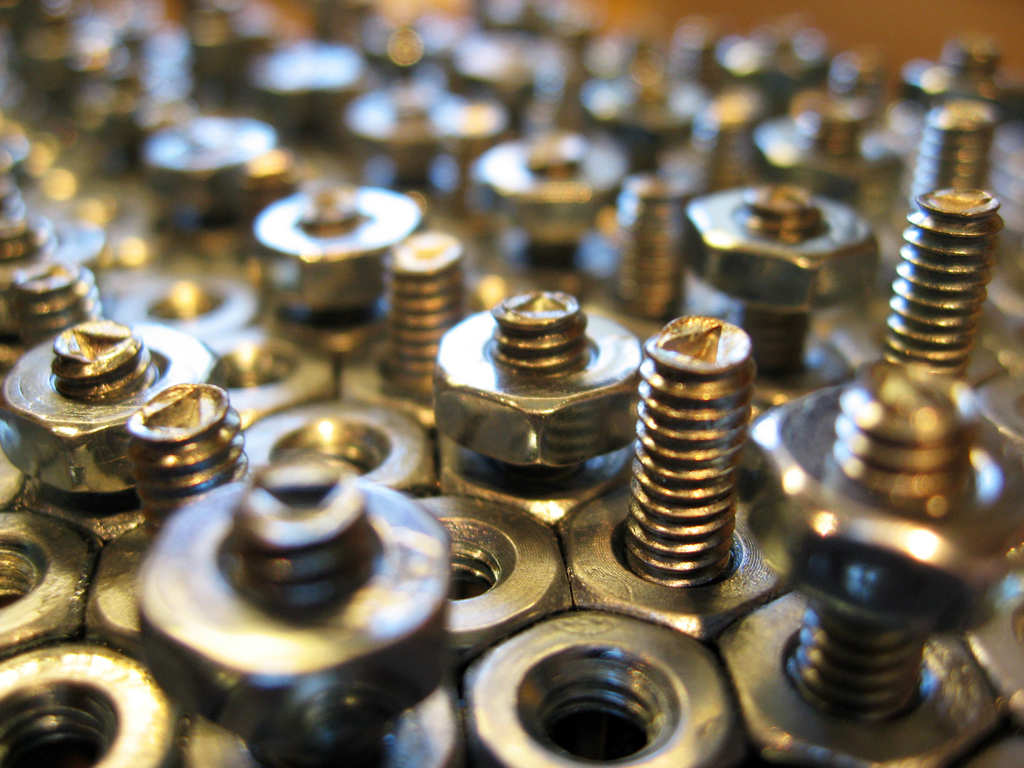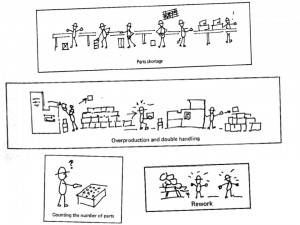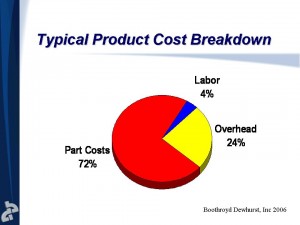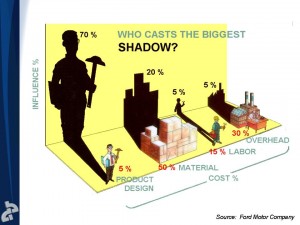Archive for the ‘DFA’ Category
DFMA to Control Controller Design – Design2Part Magazine
Design for Manufacture and Assembly is reported to improve CNC performance, modularity, durability, and serviceability
When Hypertherm (www.hypertherm.com) was getting ready to design its next generation of metal cutting CNCs, the engineering team’s goal was to make improvements. But the controllers, which automate the Hanover, New Hampshire-based company’s advanced cutting tools and systems, were already well-accepted in the marketplace and highly regarded in the industry. So why redesign? And how would they go about it?
See this link for the full article – Using DFMA to Control Controller Design
Fasteners Can Consume 20-50% of Assembly Labor
 The data-driven people in our lives tell us that you can’t improve what you can’t measure. I believe that. And it’s no different with product cost. Before improving product cost, before designing it out, you have to know where it is. However, it can be difficult to know what really creates cost. Not all parts and features are created equal; some create more cost than others, and it’s often unclear which are the heavy hitters. Sometimes the heavy hitters don’t look heavy, and often are buried deeply within the hidden factory.
The data-driven people in our lives tell us that you can’t improve what you can’t measure. I believe that. And it’s no different with product cost. Before improving product cost, before designing it out, you have to know where it is. However, it can be difficult to know what really creates cost. Not all parts and features are created equal; some create more cost than others, and it’s often unclear which are the heavy hitters. Sometimes the heavy hitters don’t look heavy, and often are buried deeply within the hidden factory.
Measure, measure, measure. That’s what the black belts say. However, it’s difficult to do well with product cost since our costing methods are hosed up and our measurement systems are limited. What do I mean? Consider fasteners (e.g., nuts, bolts, screws, and washers), the product’s most basic life form. Because fasteners are not on the BOM, they’re not part of product cost. Here’s the party line: it’s overhead to be shared evenly across all the products in a socialist way. That’s not a big deal, right? Wrong. Although fasteners don’t cost much in ones and twos, they do add up. 300-500 pieces per unit times the number of units per year makes for a lot of unallocated and untracked cost. However, a more significant issue with those little buggers is they take a lot of time attach to the product. For example, using standard time data from DFMA software, assembly of a 1/4″ nut with a bolt, locktite, a lockwasher, and cleanup takes 50 seconds. That’s a lot of time. You should be asking yourself what that translates to in your product. To figure it out, multiply the number nut/bolt/washer groupings by 50 seconds and multiply the result by the number of units per year. Actually, never mind. You can’t do the calculation because you don’t know the number of nut/bolt/washer combinations that are in your product. You could try to query your BOMs, but the information is likely not there. Remember, fasteners are overhead and not allocated to product. Have you ever tried to do a cost reduction project on overhead? It’s impossible. Because overhead inflicts pain evenly to all, no one is responsible to reduce it.
With fasteners, it’s like death by a thousand cuts.
The time to attach them can be as much as 20-50% of labor. That’s right, up to 50%. That’s like paying 20-50% of your folks to attach fasteners all day. That should make you sick. But it’s actually worse than that. From Line Design 101, the number of assembly stations is proportional to demand times labor time. Since fasteners inflate labor time, they also inflate the number of assembly stations, which, in turn, inflates the factory floor space needed to meet demand. Would you rather design out fasteners or add 15% to your floor space? I know you can get good deals on factory floor space due to the recession, but I’d still rather design out fasteners.
Even with the amount of assembly labor consumed by fasteners, our thinking and computer systems are blind to them and the associated follow-on costs. And because of our vision problems, the design community cannot be held accountable to design out those costs. We’ve given them the opportunity to play dumb and say things like, “Those fastener things are free. I’m not going to spend time worrying about that. It’s not part of the product cost.” Clearly not an enlightened statement, but it’s difficult to overcome without cost allocation data for the fasteners.
The work-around for our ailing thinking and computer-based cost tracking systems is simple: get the design engineers out to the production floor to build the product. Have them experience first hand how much waste is in the product. They’ll come back with a deep-in-the-gut understanding of how things really are. Then, have them use DFMA software to score the existing design, part-by-part, feature-by-feature. I guarantee everyone will know where the cost is after that. And once they know where the cost is, it will be easy for them to design it out.
I have data to support my assertion that fasteners can make up 20-50% of labor time, but don’t take my word for it. Go out to the factory floor, shut your eyes and listen. You’ll likely hear the never ending song of the nut runners. With each chirp, another nut is fastened to its bolt and washer, and another small bit of labor and factory floor space is consumed by the lowly fastener.
DFA and Lean – A Most Powerful One-Two Punch
 Lean is all about parts. Don’t think so? What do your manufacturing processes make? Parts. What do your suppliers ship you? Parts. What do you put into inventory? Parts. What do your shelves hold? Parts. What is your supply chain all about? Parts.
Lean is all about parts. Don’t think so? What do your manufacturing processes make? Parts. What do your suppliers ship you? Parts. What do you put into inventory? Parts. What do your shelves hold? Parts. What is your supply chain all about? Parts.
Still not convinced parts are the key? Take a look at the seven wastes and add “of parts” to the end of each one. Here is what it looks like:
- Waste of overproduction (of parts)
- Waste of time on hand – waiting (for parts)
- Waste in transportation (of parts)
- Waste of processing itself (of parts)
- Waste of stock on hand – inventory (of parts)
- Waste of movement (from parts)
- Waste of making defective products (made of parts)
And look at Suzaki’s cartoons. (Click them to enlarge.) What do you see? Parts.
Take out the parts and the waste is not reduced, it’s eliminated. Let’s do a thought experiment, and pretend your product had 50% fewer parts. (I know it’s a stretch.) What would your factory look like? How about your supply chain? There would be: fewer parts to ship, fewer to receive, fewer to move, fewer to store, fewer to handle, fewer opportunities to wait for late parts, and fewer opportunities for incorrect assembly. Loosen your thinking a bit more, and the benefits broaden: fewer suppliers, fewer supplier qualifications, fewer late payments; fewer supplier quality issues, and fewer expensive black belt projects. Most importantly, however, may be the reduction in the transactions, e.g., work in process tracking, labor reporting, material cost tracking, inventory control and valuation, BOMs, routings, backflushing, work orders, and engineering changes.
However, there is a big problem with the thought experiment — there is no one to design out the parts. Since company leadership does not thrust greatness on the design community, design engineers do not have to participate in lean. No one makes them do DFA-driven part count reduction to compliment lean. Don’t think you need the design community? Ask your best manufacturing engineer to write an engineering change to eliminates parts, and see where it goes — nowhere. No design engineer, no design change. No design change, no part elimination.
It’s staggering to think of the savings that would be achieved with the powerful pairing of DFA and lean. It would go like this: The design community would create a low waste design on which the lean community would squeeze out the remaining waste. It’s like the thought experiment; a new product with 50% fewer parts is given to the lean folks, and they lean out the low waste value stream from there. DFA and lean make such a powerful one-two punch because they hit both sides of the waste equation.
DFA eliminates parts, and lean reduces waste from the ones that remain.
There are no technical reasons that prevent DFA and lean from being done together, but there are real failure modes that get in the way. The failure modes are emotional, organizational, and cultural in nature, and are all about people. For example, shared responsibility for design and manufacturing typically resides in the organizational stratosphere – above the VP or Senior VP levels. And because of the failure modes’ nature (organizational, cultural), the countermeasures are largely company-specific.
What’s in the way of your company making the DFA/lean thought experiment a reality?
DFA Saves More than Six Sigma and Lean
I can’t believe everyone isn’t doing Design for Assembly (DFA), especially in these tough economic times. It’s almost like CEOs really don’t want to grow stock price. DFA, where the product design is changed to reduce the cost of putting things together, routinely achieves savings of 20-50% in material cost, and the same for labor cost. And the beauty of the material savings is that it falls right to the bottom line. For a product that costs $1000 with 60% material cost ($600) and 10% profit margin ($100), a 10% reduction in material cost increases bottom line contribution by 60% (from $100 to $160). That sounds pretty good to me. But, remember, DFA can reduce material cost by 50%. Do that math and, when you get up off the floor, read on.
Unfortunately for DFA, the savings are a problem – they’re too big to be believed. That’s right, I said too big. Here’s how it goes. An engineer (usually an older one who doesn’t mind getting fired, or a young one who doesn’t know any better) brings up DFA in a meeting and says something like, “There’s this crazy guy on the web writing about DFA who says we can design out 20-50% of our material cost. That’s just what we need.” A pained silence floods the room. One of the leaders says something like, “Listen, kid, the only part you got right is calling that guy crazy. We’re the world leaders in our field. Don’t you think we would have done that already if it was possible? We struggle to take out 2-3% material cost per year. Don’t talk about 20-50% because is not possible.” DFA is down for the count.
Also unfortunate is the name – DFA. You’ve got to admit DFA doesn’t roll off the tongue like six sigma which also happens to sound like sex sigma, where DFA does not. I think we should follow the lean sigma trend and glom some letters onto DFA so it can ride the coat tails of the better known methodologies. Here are some letters that could help:
Lean DFA; DFA Lean; Six Sigma DFA; Six DFA Sigma (this one doesn’t work for me); Lean DFA Sigma
Its pedigree is also a problem – it’s not from Toyota, so it can’t be worth a damn. Maybe we should make up a story that Deming brought it to Japan because no one in the west would listen to him, and it’s the real secret behind Toyota’s success. Or, we can call it Toyota DFA. That may work.
Though there is some truth to the previous paragraphs, the main reason no one is doing DFA is simple:
No one is asking the design community to do DFA.
Here is the rationalization: The design community is busy and behind schedule (late product launches). If we bother them with DFA, they may rebel and the product will never launch. If we leave them alone and cross our fingers, maybe things will be all right. That is a decision made in fear, which, by definition, is a mistake.
The design community needs greatness thrust upon them. It’s the only way.
Just as the manufacturing community was given no choice about doing six sigma and lean, so should the design community be given no choice about doing DFA.
No way around it, the first DFA effort is a leap of faith. The only way to get it off the ground is for a leader in the organization to stand up and say “I want to do DFA.” and then rally the troops to make it happen.
I urge you to think about DFA in the same light as six sigma or lean: If your company had a lean or six sigma project that would save you 20-50% on your product cost, would you do it? I think so.
Who in your organization is going to stand up and make it happen?
Product Design – the most powerful (and missing) element of lean
Lean has been beneficial for many companies, helping improve competitiveness and profitability. But, lean has not been nearly as effective as it can be because there is a missing ingredient – product design. Where lean can reduce the waste of making and moving parts, product design can eliminate the parts altogether; where lean can reduce setup times for big machines, product design can change the parts so they no longer need the big machines; where lean can reduce inventory, product design can eliminate it by designing out parts; where lean can make the supply chain more efficient, product design can radically shorten it by designing out the long lead time elements.
The power of product design is even more evident when considering the breakdown of product cost. Here is some data from Nick Dewhurst taken from multiple-hundred DFMA analyses showing the typical cost breakdown of products.
Of the three buckets of cost, material cost is by far the largest 74%, and this is where product development shines. Product design can eliminate 40 to 50% of material cost resulting in radical cost savings. Lean cannot. I will go a bit further and say that material cost reductions are largely off limits to the lean folks since it requires fundamental product changes.
Side note – Probably most surprising about cost breakdown data is labor cost is only 4%. Why we move our manufacturing to “low cost countires” to chase 50% labor reductions to net a whopping 2% cost reduction is beyond me, but that’s for a different post.
Let’s face it – material cost reduction is where it’s at, and lean does not have the toolbox to reduce material cost. There’s no mystery here. What is mysterious, however, is that companies looking to survive at all costs are not pulling the biggest lever at their disposal – product design. Here is a bit of old data from Ford showing that Product Design has the biggest lever on cost. We’ve know this for a long time, but we still don’t do it.
Clearly, the best approach of is to combine the power of product design with lean. It goes like this: the engineers design a low cost, low waste product that is introduced to the production line, and the lean folks improve efficiency and reduce cost from there. We’ve got the lean part down, but not the product design part.
There are two things in the way of designing low cost, low waste products in a way that helps take lean to the next level. First, product development teams don’t know how to do the work. To overcome this, train them in DFMA. Second, and most important, company leaders don’t give the product development teams the tools, time, and training to do the work. Company leaders won’t take the time to do the work because they think it will delay product launches. Also, they don’t want to invest in the tools and training because the cost is too high, even though a little math shows the investment is more than paid back with the first product launch. To fix that, educate them on the methods, the resource needs, and the savings.
Good luck.
How to organize for Lean / Six Sigma
John Teresco of Industry Week wrote a good article that shows how up upfront design enables the next level of improvments in Lean and Six Sigma.
Here are several excerpts:
At Hypertherm Inc., a manufacturer of plasma cutting systems, the DFMA software enabled a first pass part count reduction as high as 50%, says Mike Shipulski, Hypertherm’s director of engineering. About 500 parts were eliminated from the product, a main power supply sub-assembly that originally contained about 1,000 parts. Shipulski says the resulting reduction in assembly floor space requirements made it possible to satisfy a growing market demand within the existing building. “We didn’t have to add floor space.” Read the rest of this entry »
“Hyper” for Lean
“Hyper” for Lean — Lean Directions, SME
Hypertherm’s lean journey began in 1997 as a natural and enthusiastic extension of its long history of continuous improvement. Founded in 1968, the company’s “lean vision” includes training, application of 5S components, visual factory audits, single and mixed-model flow lines and the engagement of its product design functions.
A recent Hypertherm success is found in the company’s HyPerformance series of plasma arc, metalcutting systems. The company’s product design community designed a product line with Read the rest of this entry »
Allocating Responsibility for Manufacturing Cost
 John Teresco of Industry Week wrote a thought-provoking article on assigning responsibility of product cost to the design engineering community (and not to the manufacturing community).
John Teresco of Industry Week wrote a thought-provoking article on assigning responsibility of product cost to the design engineering community (and not to the manufacturing community).
An expert from his article:
“We in the United States have mistakenly allocated the responsibility for [production] cost to the manufacturing folks. We forget that the cost has already been designed into the product.”
That’s Mike Shipulski, director of engineering with plasma cutting technology provider Hypertherm Inc., reflecting on one of the lessons learned from implementing Design for Manufacturing and Assembly (DFMA) software. The accomplishments include a 600% increase in profit per square foot of factory floor space within a five-year redesign program. Correspondingly, warranty cost per unit declined more than 75% during the same period, from January 2003 to January 2008.
Measuring DFMA Savings
Wes Iverson, Managing Editor of Automation World, wrote a good artcle on DFMA’s ability to cut product cost, reduce part count, and save assembly floor space.
Measuring DFMA Savings — Automation World
An expert from his article:
When a Hypertherm team led by Shipulski designed a major new plasma cutting machine several years ago, the team was able to reduce the number of parts required to about 700, down from around 1,400 in the previous generation design. The result was a machine that took about four hours to build, compared to 10 hours for the previous unit, enabling Hypertherm to hit its 35 percent cost reduction target for the system.
Design for Manufacture and Assembly Helps OEM Reduce Warranty Costs, Boost Profits
Design2Part Magazine published a good article on DFMA’s ability to cut costs, labor, floor space and improve global competitiveness.
An expert from the article:
Five-year implementation of DFMA software creates strong business model for improving global competitiveness
“We started with a vision to make radical improvements in both product performance and product economies,” stated Mike Shipulski, Hypertherm’s director of engineering. “Hypertherm met both of these goals by aggressively applying Boothroyd Dewhurst’s software within our existing programs for robust design and lean manufacturing. We found their product simplification software made it easy for us to improve a product’s performance-to-cost ratio. Moreover, we learned that DFMA ideas and financial estimates also lead to profound savings beyond labor and part cost, creating a domino effect ‘downstream’ in operational areas of our organization.”
Successful Design For Assembly
Successful Design For Assembly
Each company works with design for assembly (DFA) methods for different reasons. Some companies want to take cost out of their products, some want to make more products in their factories, and some want to simplify the product to increase quality and reliability.
In a growing market, a company wants to reduce labor content to get more products through the factory and to meet demand without adding assembly workers. In a growing market, a company also wants to reduce the floor space required to meet demand without building another factory. Read the rest of this entry »



 Mike Shipulski
Mike Shipulski